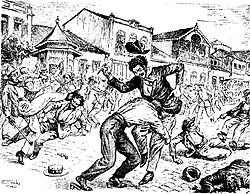|
Cabeçada
Cabeçada (pronounced: ka-be-SA-da, lit. headbutt) is a headbutt in capoeira. It is a commonly used strike[1] and one of the fundamental techniques in traditional capoeira.[2] Although simple to execute, headbutt is one of the most dangerous moves, often causing fatalities.[3] Headbutt was a deadly technique in 19th century capoeira carioca. In the contemporary capoeira game, violent headbutts are generally avoided. In capoeira, there are specific head butts, such as arpão de cabeça (head harpoon) and escorumelo. History The sole major addition to capoeira, aside its engolo kicking core, was headbutting, a common African practice in the Americas, known as jogo de cabeçadas.[4] In the 19th century, headbutts were the capoeiras' primary technique, as per police records.[5] Between 1822 and 1824, the German painter Johann Moritz Rugendas described capoeira as a headbutting game:
In capoeira carioca, cabeçada was a deadly technique. An English visitor to Rio de Janeiro wrote in 1826 on this lethal technique:
Lethal headbutt techniques were used in the 19th century Bahia also:
Although headbutts was prominent in street-fighting capoeira due to their effectiveness, it remained relatively infrequent in the game environment.[4] In modern capoeira, headbutts are used more as a defensive tactic to keep a dangerously close opponent at bay rather than as a prominent technique.[4] Technique To perform a headbutt, the capoeirista lowers their body and launches themselves towards the opponent, striking them with the forehead. The headbutt can be delivered to various regions of the body. The preferred targets are: [3][8]
As long as there's an opening in the defense, the possibility of a headbutt remains imminent. In this technique, the attacker rapidly approaches, gliding their head along the opponent's chest, usually targeting the chin, nose, or forehead upon contact.[1] It's crucial to emphasize that this technique should never be fully executed in a game situation due to its serious consequences.[1] According to mestre Pastinha, the headbutt under the jaw, from bottom to top, is very dangerous and can be applied when the opponent is very close.[8] According to mestre Bimba, "its application requires a lot of cunning."[9] ApplicationAccording to mestre Pastinha, cabeçada is a malicious blow that can be applied to the chest or face, with a quick turn of the body when the opponent believes the attacker is withdrawing.[8] Capoeiristas use a variety of tricks to execute headbutts. For example, in ginga, they may tilt their body to a side as if dodging, but instead prepare for a headbutt if there is enough distance.[3] Capoeirista may also drop objects and then deliver a headbutt when picking them up, especially when facing inexperienced opponent.[3] In addition, if a capoeirista is held by two men, they can free themselves by lowering their body and delivering a headbutt.[3] VariationsIn capoeira carioca, headbutts were so important that they had different names depending on how they were performed. For example, the caveira no espelho, meaning "skull in a mirror," was a standing headbutt to the face, while the cocada was an upward headbutt under the chin.[5] Cocada (coconut) The cocada headbutt is a simple but effective move. To perform it, the attacker approaches the opponent and suddenly lowers themselves, striking the opponent with their head on the underside of the jaw, chest, stomach, or even the face.[10] This move is similar to the rabo de arraia in its consequences, as it can be very disorienting and even terrifying for the recipient when executed correctly.[10] Arpão de cabeça (head harpoon)Arpão de cabeça (head harpoon) is a violent headbutt, where the attacker uses the entire weight of his body.[11] The arms are initially crossed in front of the player's face to shield it from a knee strike. Upon impact, the arms are then opened, enhancing the power of the movement directed towards the adversary's chest or stomach.[11] DefensesPossible defense from headbutt is to throw the body backward, and strike the back of the attacker's head with the hand.[8] Or to quickly descends as soon as notice the attacker's intentions, and kick him with the foot from bottom to top.[8] See alsoWikimedia Commons has media related to Cabeçada. Literature
References
|
||||||||||||||||||||
